Презентация ch04 smart principlesacct 5 ppt short




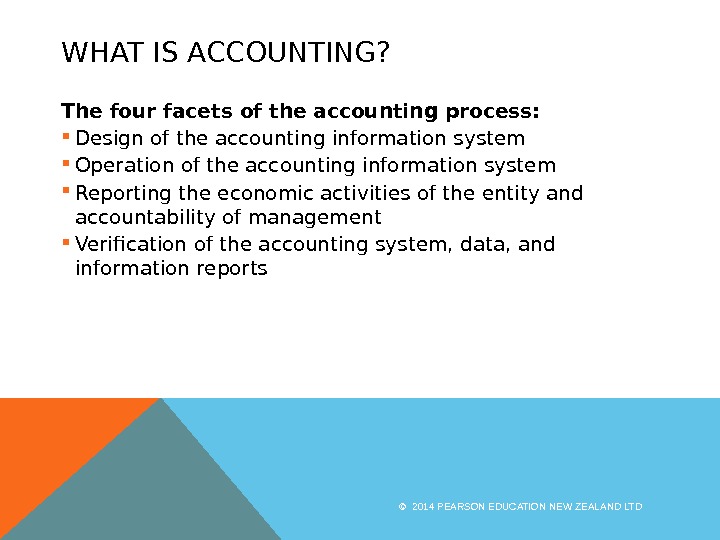




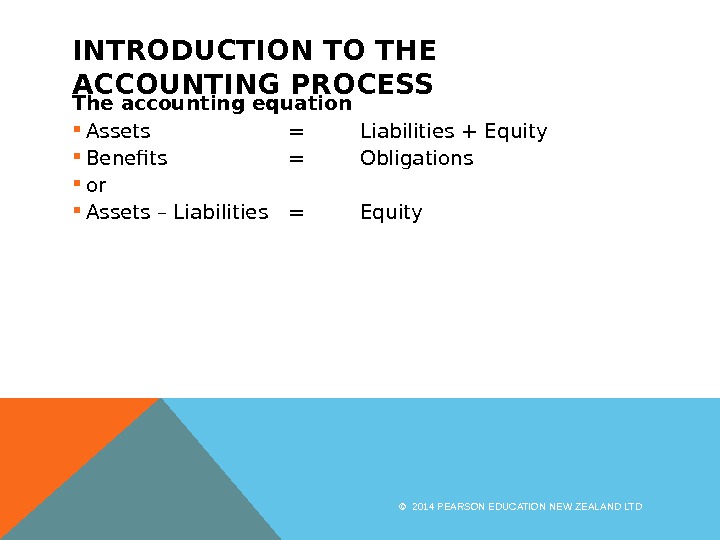


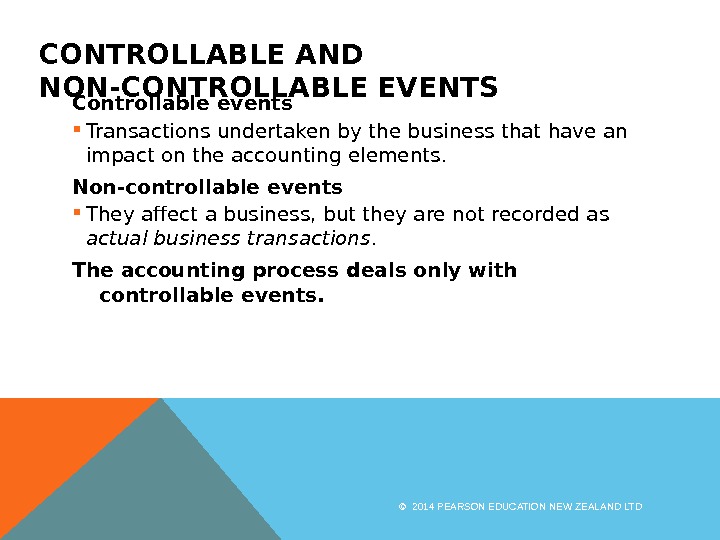

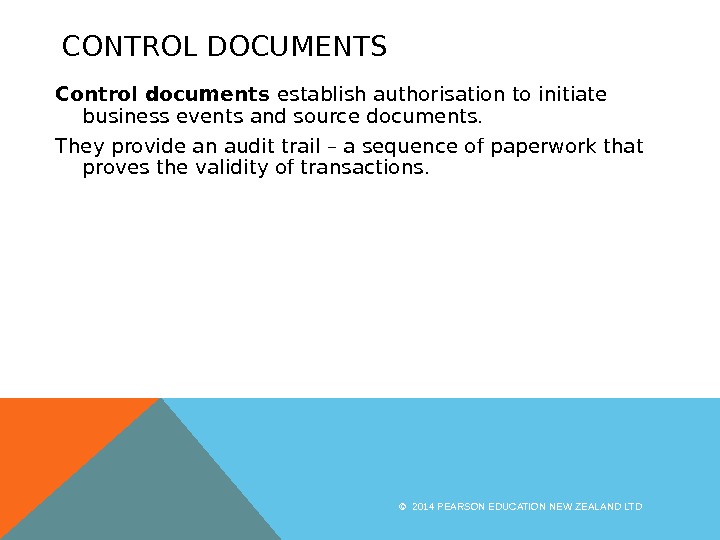
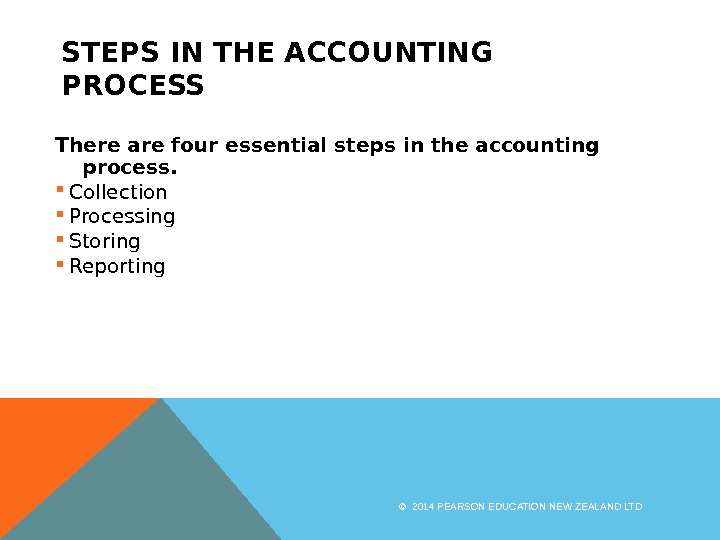
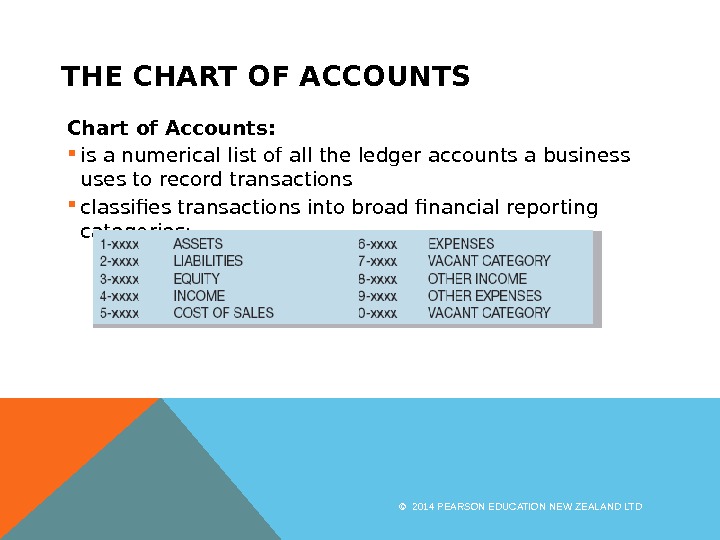

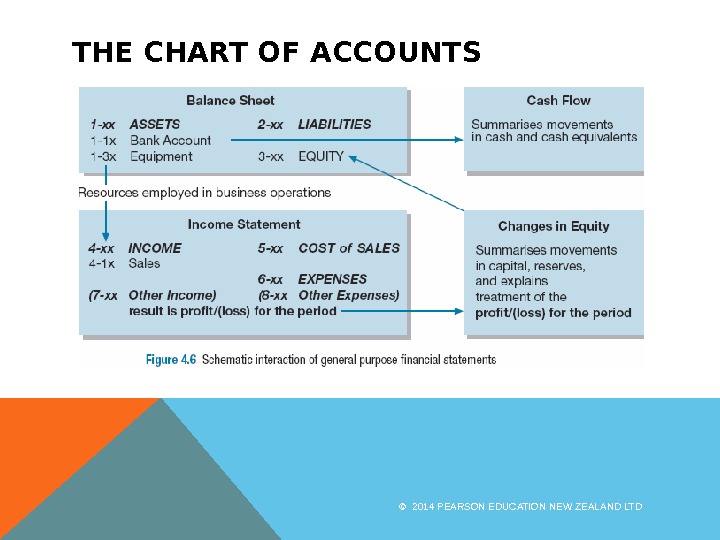
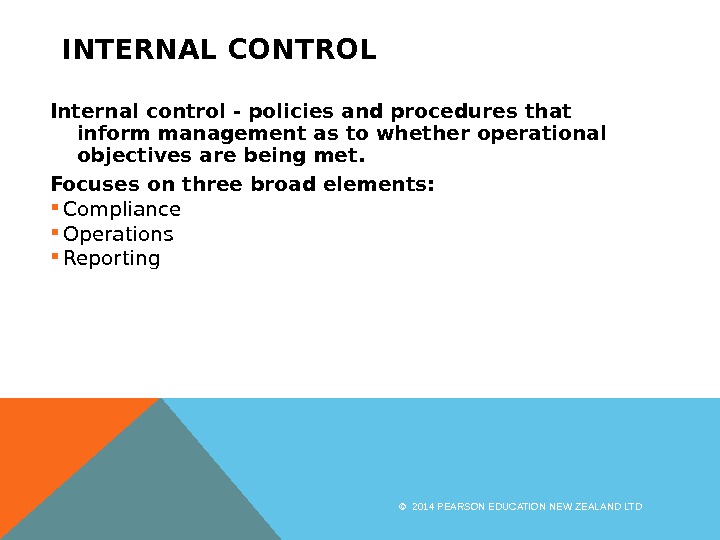

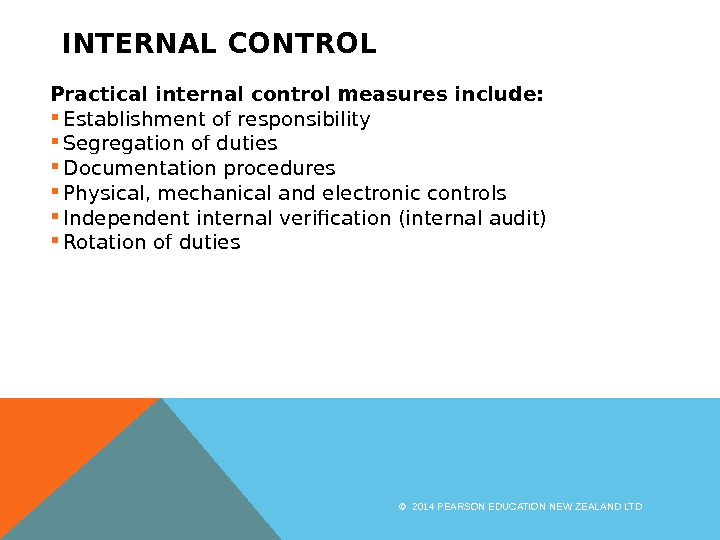

- Размер: 493 Кб
- Количество слайдов: 22
Описание презентации Презентация ch04 smart principlesacct 5 ppt short по слайдам
 P R IN C IP L E S O F A C C O U N T IN G CHAPTER FO UR THE ACCO UNTING PRO CESS© 2014 PEARSON EDUCATION NEW ZEALAND LT
P R IN C IP L E S O F A C C O U N T IN G CHAPTER FO UR THE ACCO UNTING PRO CESS© 2014 PEARSON EDUCATION NEW ZEALAND LT
 THE ACCOUNTING PROCESS After studying this chapter you should be able to: explain the nature and importance of accounting information describe the uses of accounting information discuss the concepts underlying the accounting process explain the steps in the accounting process design and explain the importance of the Chart of Accounts understand the objectives of internal control © 2014 PEARSON EDUCATION NEW ZEALAND LT
THE ACCOUNTING PROCESS After studying this chapter you should be able to: explain the nature and importance of accounting information describe the uses of accounting information discuss the concepts underlying the accounting process explain the steps in the accounting process design and explain the importance of the Chart of Accounts understand the objectives of internal control © 2014 PEARSON EDUCATION NEW ZEALAND LT
 WHAT IS ACCOUNTING? Accounting was defined by Paul F. Grady as: … the body of knowledge and functions concerned with systematic originating, authenticating, recording, classifying, processing, summarizing, analyzing, interpreting, and supplying of dependable and significant information covering transactions and events which are, in part at least, of a financial character, required for the management and operation of an entity and for the reports that have to be submitted thereon to meet fiduciary and other responsibilities. © 2014 PEARSON EDUCATION NEW ZEALAND LT
WHAT IS ACCOUNTING? Accounting was defined by Paul F. Grady as: … the body of knowledge and functions concerned with systematic originating, authenticating, recording, classifying, processing, summarizing, analyzing, interpreting, and supplying of dependable and significant information covering transactions and events which are, in part at least, of a financial character, required for the management and operation of an entity and for the reports that have to be submitted thereon to meet fiduciary and other responsibilities. © 2014 PEARSON EDUCATION NEW ZEALAND LT
 WHAT IS ACCOUNTING? The four facets of the accounting process: Design of the accounting information system Operation of the accounting information system Reporting the economic activities of the entity and accountability of management Verification of the accounting system, data, and information reports © 2014 PEARSON EDUCATION NEW ZEALAND LT
WHAT IS ACCOUNTING? The four facets of the accounting process: Design of the accounting information system Operation of the accounting information system Reporting the economic activities of the entity and accountability of management Verification of the accounting system, data, and information reports © 2014 PEARSON EDUCATION NEW ZEALAND LT
 WHY IS FINANCIAL INFORMATION IMPORTANT? Financial information: Measures the economic health of a business Provides information to enable management and stakeholders to make decisions No business can succeed without this information © 2014 PEARSON EDUCATION NEW ZEALAND LT
WHY IS FINANCIAL INFORMATION IMPORTANT? Financial information: Measures the economic health of a business Provides information to enable management and stakeholders to make decisions No business can succeed without this information © 2014 PEARSON EDUCATION NEW ZEALAND LT
 WHO USES THE INFORMATION? • Internal users: • Those working within the business who create the information • External users: • Those outside the business who are affected by its business operations © 2014 PEARSON EDUCATION NEW ZEALAND LT
WHO USES THE INFORMATION? • Internal users: • Those working within the business who create the information • External users: • Those outside the business who are affected by its business operations © 2014 PEARSON EDUCATION NEW ZEALAND LT
 INTRODUCTION TO THE ACCOUNTING PROCESS The entity concept The affairs of a business entity are kept separate from those of its owner(s). The business entity requires finance to create wealth for the owners. Financing is a combination of: funds from the owners, funds borrowed from financiers and creditors, and profits retained in the business. © 2014 PEARSON EDUCATION NEW ZEALAND LT
INTRODUCTION TO THE ACCOUNTING PROCESS The entity concept The affairs of a business entity are kept separate from those of its owner(s). The business entity requires finance to create wealth for the owners. Financing is a combination of: funds from the owners, funds borrowed from financiers and creditors, and profits retained in the business. © 2014 PEARSON EDUCATION NEW ZEALAND LT
 INTRODUCTION TO THE ACCOUNTING PROCESS © 2014 PEARSON EDUCATION NEW ZEALAND LT
INTRODUCTION TO THE ACCOUNTING PROCESS © 2014 PEARSON EDUCATION NEW ZEALAND LT
 INTRODUCTION TO THE ACCOUNTING PROCESS The accounting equation Assets = Liabilities + Equity Benefits = Obligations or Assets – Liabilities = Equity © 2014 PEARSON EDUCATION NEW ZEALAND LT
INTRODUCTION TO THE ACCOUNTING PROCESS The accounting equation Assets = Liabilities + Equity Benefits = Obligations or Assets – Liabilities = Equity © 2014 PEARSON EDUCATION NEW ZEALAND LT
 PRINCIPLE OF DOUBLE ENTRY For each transaction there must be balancing debit and credit entries made to accounts in the ledger. Ledger – a book containing accounts to which debits and credits are posted from journals (the books of original entry). © 2014 PEARSON EDUCATION NEW ZEALAND LT
PRINCIPLE OF DOUBLE ENTRY For each transaction there must be balancing debit and credit entries made to accounts in the ledger. Ledger – a book containing accounts to which debits and credits are posted from journals (the books of original entry). © 2014 PEARSON EDUCATION NEW ZEALAND LT
 THE BASIS FOR RECORDING FINANCIAL TRANSACTIONS Monetary convention – the expressing of financial transactions in a common currency. Historical cost concept – the practice of recording transactions at their original cost or value. © 2014 PEARSON EDUCATION NEW ZEALAND LT
THE BASIS FOR RECORDING FINANCIAL TRANSACTIONS Monetary convention – the expressing of financial transactions in a common currency. Historical cost concept – the practice of recording transactions at their original cost or value. © 2014 PEARSON EDUCATION NEW ZEALAND LT
 CONTROLLABLE AND NON-CONTROLLABLE EVENTS Controllable events Transactions undertaken by the business that have an impact on the accounting elements. Non-controllable events They affect a business, but they are not recorded as actual business transactions. The accounting process deals only with controllable events. © 2014 PEARSON EDUCATION NEW ZEALAND LT
CONTROLLABLE AND NON-CONTROLLABLE EVENTS Controllable events Transactions undertaken by the business that have an impact on the accounting elements. Non-controllable events They affect a business, but they are not recorded as actual business transactions. The accounting process deals only with controllable events. © 2014 PEARSON EDUCATION NEW ZEALAND LT
 THE ROLE OF SOURCE DOCUMENTS A source document identifies the transaction and gives it a monetary value. Source documents include: purchase and sales invoices, cheque butts, receipts, cash sales dockets, credit and debit notes, and internal adjustment notes. © 2014 PEARSON EDUCATION NEW ZEALAND LT
THE ROLE OF SOURCE DOCUMENTS A source document identifies the transaction and gives it a monetary value. Source documents include: purchase and sales invoices, cheque butts, receipts, cash sales dockets, credit and debit notes, and internal adjustment notes. © 2014 PEARSON EDUCATION NEW ZEALAND LT
 CONTROL DOCUMENTS Control documents establish authorisation to initiate business events and source documents. They provide an audit trail – a sequence of paperwork that proves the validity of transactions. © 2014 PEARSON EDUCATION NEW ZEALAND LT
CONTROL DOCUMENTS Control documents establish authorisation to initiate business events and source documents. They provide an audit trail – a sequence of paperwork that proves the validity of transactions. © 2014 PEARSON EDUCATION NEW ZEALAND LT
 STEPS IN THE ACCOUNTING PROCESS There are four essential steps in the accounting process. Collection Processing Storing Reporting © 2014 PEARSON EDUCATION NEW ZEALAND LT
STEPS IN THE ACCOUNTING PROCESS There are four essential steps in the accounting process. Collection Processing Storing Reporting © 2014 PEARSON EDUCATION NEW ZEALAND LT
 THE CHART OF ACCOUNTS Chart of Accounts: is a numerical list of all the ledger accounts a business uses to record transactions classifies transactions into broad financial reporting categories: © 2014 PEARSON EDUCATION NEW ZEALAND LT
THE CHART OF ACCOUNTS Chart of Accounts: is a numerical list of all the ledger accounts a business uses to record transactions classifies transactions into broad financial reporting categories: © 2014 PEARSON EDUCATION NEW ZEALAND LT
 THE CHART OF ACCOUNTS Links the four principle accounting statements: Balance sheet, Income statement, Statement of changes in equity, and Cash flow statement. © 2014 PEARSON EDUCATION NEW ZEALAND LT
THE CHART OF ACCOUNTS Links the four principle accounting statements: Balance sheet, Income statement, Statement of changes in equity, and Cash flow statement. © 2014 PEARSON EDUCATION NEW ZEALAND LT
 THE CHART OF ACCOUNTS © 2014 PEARSON EDUCATION NEW ZEALAND LT
THE CHART OF ACCOUNTS © 2014 PEARSON EDUCATION NEW ZEALAND LT
 INTERNAL CONTROL Internal control — policies and procedures that inform management as to whether operational objectives are being met. Focuses on three broad elements: Compliance Operations Reporting © 2014 PEARSON EDUCATION NEW ZEALAND LT
INTERNAL CONTROL Internal control — policies and procedures that inform management as to whether operational objectives are being met. Focuses on three broad elements: Compliance Operations Reporting © 2014 PEARSON EDUCATION NEW ZEALAND LT
 INTERNAL CONTROL For internal control strategies to work as intended, five principles: Attitude, Assessment, Activity, Advice, and Audit must be followed. © 2014 PEARSON EDUCATION NEW ZEALAND LT
INTERNAL CONTROL For internal control strategies to work as intended, five principles: Attitude, Assessment, Activity, Advice, and Audit must be followed. © 2014 PEARSON EDUCATION NEW ZEALAND LT
 INTERNAL CONTROL Practical internal control measures include: Establishment of responsibility Segregation of duties Documentation procedures Physical, mechanical and electronic controls Independent internal verification (internal audit) Rotation of duties © 2014 PEARSON EDUCATION NEW ZEALAND LT
INTERNAL CONTROL Practical internal control measures include: Establishment of responsibility Segregation of duties Documentation procedures Physical, mechanical and electronic controls Independent internal verification (internal audit) Rotation of duties © 2014 PEARSON EDUCATION NEW ZEALAND LT
 INTERNAL CONTROL Problems with internal control: Small businesses do not have the necessary staff numbers The costs of many internal control procedures could outweigh the advantages Must identify the likely risk areas, and concentrate control measures in those areas © 2014 PEARSON EDUCATION NEW ZEALAND LT
INTERNAL CONTROL Problems with internal control: Small businesses do not have the necessary staff numbers The costs of many internal control procedures could outweigh the advantages Must identify the likely risk areas, and concentrate control measures in those areas © 2014 PEARSON EDUCATION NEW ZEALAND LT

